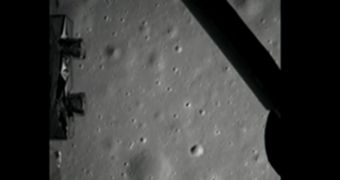In a historic achievement, China landed its first robotic explorer on the surface of the Moon, thus becoming only the third country ever to do that. A soft landing on the Moon was last achieved by the Soviet Union, in 1976. The United States is the only other country that achieved this feat.
The Chang'e-3 lander and Yutu rover touched down on the surface of the Moon at 1311 GMT on Saturday, December 14, just 12 days after the mission launched from the Xichang Satellite Launch Center, in Sichuan, aboard a Long March 3B heavy-lift delivery system.
Mission controllers at the Beijing Aerospace Control Center went through 12 minutes of dread before the soft landing was achieved. Over the final 15 kilometers (9.3 miles) of its descent, the spacecraft was out of contact, and relied exclusively on its domestically designed and manufactured engine.
After the lander got within a few meters of the lunar surface, the thruster shut down, and the probe thumped on the ground close to Sinus Iridium, or the Bay of Rainbows, one of the most beautiful landscape features on the Moon, Nature reports.
Though the Bay of Rainbows was its original target, Chinese scientists confirmed that the probe landed a bit to the east, inside Mare Imbrium, or the Sea of Rains. The error is not significant, and does not impact mission parameters in any way.
Additional cheering and handshaking took place in Beijing around 7 hours after the spacecraft landed, when the 140-kilogram (309-pound), six-wheeled Yutu rover drove off a ramp on Chang'e-3, and took its first steps on the lunar surface.
The main instrument on Yutu – or Jade Rabbit – is a radar capable of peering up to 100 meters (330 feet) below the lunar surface. This is a great asset since the mission touched down in an area known for its freshly-deposited basalts, which researchers say could give more insights into the origins of the Moon.
Yutu's mission is scheduled to last for at least three months, whereas the Chang'e-3 lander will act as an astronomical observatory in Mare Imbrium for at least a year.
This is undoubtedly a historic moment for the Chinese National Space Administration (CNSA), which launched its first two lunar probes, Chang'e-1 and Chang'e-2, in 2007 and 2010, respectively. Over the past few years, China has taken monumental steps in space exploration, highlighting its dedication to becoming an international powerhouse in space.
China sent its first astronaut in space in 2003, when Yang Liwei reached low-Earth orbit aboard the Shenzhou 5 spacecraft. A few years later, CNSA demonstrated robotic orbital docking procedures between two spacecraft, an achievement that paves the way for building its own space station.
Over the next few decades, China plans to land humans on the Moon, and construct an outpost that would enable missions to reach Mars easier. A manned mission to the Red Planet is scheduled to take place in the 2040-2060 time frame. Ahead of such an attempt, a satellite-based space weather monitoring system will be assembled in Earth's L1 Lagrangian point.

 14 DAY TRIAL //
14 DAY TRIAL //